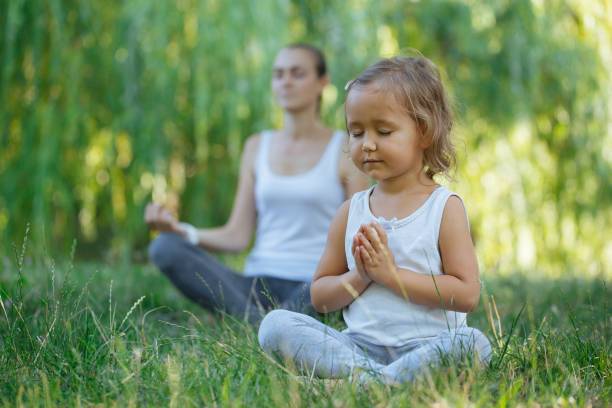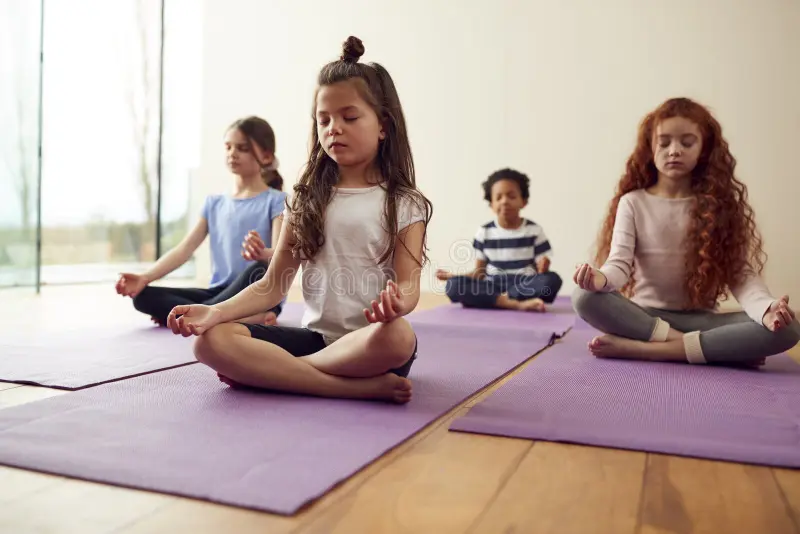In today’s fast-paced world, children face challenges that were once considered exclusive to adults. From academic pressure to digital distractions, social stress, and constant overstimulation, their young minds often struggle to find balance. Amid these challenges, Children’s Meditation is emerging as a powerful practice to nurture mental, emotional, and even physical well-being.
This article explores children’s meditation in depth, its benefits, techniques, scientific evidence, parental guidance, and practical tips for introducing it at home and in schools.
Why is Children’s Meditation Important?
Meditation, once seen as an adult-centered spiritual discipline, is now being adapted to suit children’s unique developmental needs. Through simple breathing exercises, visualization, mindfulness games, and guided practices, children can learn how to calm their minds, regulate emotions, and build resilience. Most importantly, meditation equips them with tools for life-long well-being, creativity, and empathy.
Childhood is the foundation of emotional intelligence, creativity, and resilience. Yet, many children today live with overstimulation and anxiety. According to psychologists, children are increasingly prone to stress-related issues such as:
- Poor sleep patterns
- Shortened attention spans
- Anxiety and hyperactivity
- Difficulty managing emotions
- Academic and social pressures
Meditation helps counter these issues by teaching children how to pause, breathe, and be present. Even a few minutes of practice daily can improve focus, reduce anxiety, and promote a sense of peace.
The Science Behind Children And Meditation:
Scientific research supports the benefits of meditation for children. Some key findings include:
- Improved attention span: Mindfulness practices have been shown to increase children’s ability to concentrate in classrooms.
- Reduced anxiety and stress: Studies show that meditation reduces cortisol (stress hormone) levels in children, making them calmer.
- Emotional regulation: Children’s Meditation demonstrates better anger management, empathy, and self-control.
- Boosted brain development: Neuroscience research indicates meditation strengthens areas of the brain associated with learning, memory, and decision-making.
- Better sleep quality: Guided relaxation helps children fall asleep faster and enjoy deeper rest.
These scientific insights confirm what ancient wisdom has always suggested—meditation is not only calming but also transformative for young minds.
Benefits of Children’s Meditation:
In today’s busy and technology-driven world, children are exposed to many distractions and pressures from an early age. From schoolwork to extracurricular activities and constant use of digital devices, their minds are often restless and overstimulated. Meditation provides a safe, simple, and effective way to help children regain balance, calmness, and focus. Practiced regularly, it offers a wide range of mental, emotional, physical, and social benefits that can support children throughout their growth years.
Improves Focus and Concentration:
One of the biggest challenges children face today is staying focused. With so many distractions around, their attention span tends to shrink. Meditation trains the mind to stay present in the moment, which directly improves concentration. Breathing exercises or mindful observation activities can help children pay better attention in class, complete homework with more dedication, and perform well in exams.
Reduces Stress and Anxiety:
Children may not face adult responsibilities, but they do experience stress—whether it comes from school performance, peer pressure, or changes at home. Meditation reduces stress by calming the nervous system and lowering cortisol (the stress hormone). Simple practices like mindful breathing or visualization give children tools to manage anxiety, reduce worry, and relax more easily, even in difficult situations.
Enhances Emotional Regulation:
Children often struggle with big emotions like anger, frustration, or sadness. Without healthy coping strategies, they may become easily upset or reactive. Meditation teaches children to observe their feelings without judgment and respond calmly. For example, repeating a calming mantra like “I am safe” or “I am calm” can help them manage overwhelming emotions and improve self-control.
Boosts Creativity and Imagination:
Meditation stimulates the right side of the brain, which is responsible for creativity and imagination. Guided visualization exercises encourage children to imagine peaceful places, magical journeys, or problem-solving scenarios, which enhances their creative thinking. This not only helps in academics like writing or art but also in developing innovative approaches to challenges in daily life.
Promotes Better Sleep:
Many children suffer from irregular sleep patterns due to overstimulation or stress. Meditation relaxes the body and mind, preparing them for restful sleep. Bedtime practices like body scan meditation or guided storytelling meditation allow children to release tension, reduce nightmares, and sleep more peacefully, leading to improved energy and mood the next day.
Fosters Compassion and Kindness:
Mindfulness practices often include exercises on loving-kindness meditation, where children are encouraged to send positive thoughts to themselves, family, friends, and even strangers. This helps develop empathy, kindness, and better social relationships. Children who meditate are often more cooperative, understanding, and supportive toward others.
Builds Resilience and Confidence:
Life is full of ups and downs, and children need resilience to handle setbacks. Children’s Meditation helps them stay grounded during challenges and bounce back with a positive attitude. Over time, it builds self-confidence as children learn to trust their inner calm and strength.
Best Children’s Meditation Techniques:
Children’s Meditation should be simple, fun, and engaging so that they enjoy the process rather than view it as a task. Since kids have shorter attention spans than adults, the techniques must be interactive and often combined with imagination, stories, or playful activities. Below are some of the most effective meditation techniques for children, suitable for different age groups.
Breathing Meditation:
Breathing is the foundation of meditation, and teaching children to focus on their breath is the simplest way to introduce mindfulness.
- Balloon Breathing: Ask the child to place their hands on the belly. As they inhale, they imagine a balloon inflating in their stomach, and as they exhale, the balloon slowly deflates. This visualization helps them understand deep breathing and calms the nervous system.
- Bunny Breaths: Children take three quick sniffs through the nose (like a bunny) followed by a long exhale. This exercise is fun and helps them regulate their breath during moments of stress or excitement.
Benefits: Improves focus, reduces anxiety, and helps children become aware of their breathing patterns.
Mindfulness Meditation:
Mindfulness encourages children to observe their thoughts, feelings, and surroundings without judgment.
- Five Senses Game: Ask the child to identify five things they see, four things they can touch, three things they hear, two things they smell, and one thing they taste.
- Mindful Walking: Children walk slowly, noticing each step, how their feet touch the ground, and how their body feels as they move.
Benefits: Enhances awareness, develops patience, and trains the mind to focus on the present.
Guided Visualization:
Children have vivid imaginations, which makes visualization one of the most effective meditation techniques.
- Safe Place Meditation: Guide the child to close their eyes and imagine a calm, safe place like a beach, garden, or mountain. Encourage them to notice the sounds, colors, and feelings of being there.
- Magic Bubble Meditation: Children imagine blowing bubbles where each bubble carries away a worry or negative thought, floating into the sky until it disappears.
Benefits: Encourages creativity, reduces stress, and provides comfort by creating a mental sanctuary.
Body Scan Meditation:
This practice helps children tune into their bodies and relax tension step by step.
-
Ask the child to lie down comfortably. Starting from the toes, guide them to notice sensations in each part of the body—legs, belly, chest, arms, and head. Please encourage them to relax each part as they move upward.
Benefits: Improves relaxation, body awareness, and helps with sleep.
Mantra Meditation:
Chanting or repeating simple mantras can be very soothing for children.
- Use affirmations like “I am calm,” “I am strong,” or “I am happy.”
- For older children, simple Sanskrit mantras like Om can be introduced.
Benefits: Builds self-confidence, develops positive thinking, and calms restless minds.
Story-Based Meditation:
Stories are an excellent way to engage children in meditation.
- Butterfly Journey: Guide them to imagine being a butterfly flying freely over fields and flowers.
- Cloud Meditation: Ask them to imagine floating on a soft, fluffy cloud drifting peacefully in the sky.
Benefits: Enhances imagination, encourages relaxation, and makes meditation enjoyable.
Yoga and Mudra Meditation:
Combining meditation with yoga postures and hand mudras creates a holistic experience for children.
- Simple Yoga Poses: Child’s Pose, Cat-Cow, and Mountain Pose combined with breathing.
- Mudras: Teach them Gyan Mudra (thumb and index finger touching) to improve focus during meditation.
Benefits: Improves flexibility, balances energy, and builds discipline in a playful way.
How to Introduce Meditation to Children:
- Keep it Fun: Children respond better when meditation feels like play. Use games, stories, or visual aids.
- Start Small: Begin with 2–5 minutes, gradually extending to 10–15 minutes as they grow comfortable.
- Be Consistent: Daily practice, even if short, works better than long but irregular sessions.
- Set an Example: Children imitate adults. Parents and teachers should meditate with them.
- Use Technology Wisely: Guided meditation apps for kids can make sessions engaging.
- Create a Safe Space: A quiet, cozy corner at home or school helps children associate meditation with relaxation.
Children’s Meditation at Different Ages:
Preschool (3–5 years):
- Short breathing exercises (Balloon Breathing).
- Fun visualizations (floating clouds, magic bubbles).
- 1–3 minutes of practice.
Primary School (6–10 years):
- Simple mindfulness games.
- Visualization meditations.
- Guided body scans.
- 5–10 minutes daily.
Preteens & Teens (11–17 years):
- Mindfulness-based stress reduction (MBSR) practices.
- Journaling combined with meditation.
- Breath awareness and mantra meditation.
- 10–20 minutes daily.
Meditation in Schools:
More schools worldwide are incorporating mindfulness and meditation programs into classrooms. Benefits include:
- Reduced behavioral problems.
- Better academic performance.
- Stronger peer relationships.
- Improved attention and emotional regulation.
Teachers can introduce meditation through morning mindfulness rituals, short relaxation breaks between lessons, and guided practices before exams.
The Role of Parents:
Parents play a crucial role in nurturing meditation habits in children. Ways parents can help include:
- Modeling the practice: Meditate regularly with your child.
- Bedtime meditation: Use guided relaxation before sleep.
- Positive reinforcement: Praise children for practicing meditation.
- Incorporating fun: Use stories, music, or art to keep meditation engaging.
Challenges in Teaching Meditation to Children:
- Short attention spans: Children may find it difficult to sit still.
- Boredom or resistance: If the practice feels forced, they may resist.
- Over-scheduling: Busy routines often leave little time for mindfulness.
Solutions:
- Keep practices short and interactive.
- Use creativity—stories, drawing, or playful visualization.
- Integrate meditation into daily routines (bedtime, morning rituals, or study breaks).
Long-Term Impact of Children’s Meditation:
When children practice meditation regularly, they develop lifelong skills:
- Emotional intelligence: Better control over feelings and responses.
- Stress management: Coping strategies for academic and personal challenges.
- Healthy habits: Meditation becomes a natural part of their daily routine.
- Empathy and compassion: Building healthier relationships with peers, family, and society.
- Spiritual growth: A deeper connection with the inner self and awareness of the present moment.
Conclusion:
Meditation is not just for adults—it is a gift that can transform children’s lives. By teaching children how to pause, breathe, and reflect, we empower them to handle stress, cultivate kindness, and enhance focus. Simple, fun, and age-appropriate meditation practices can become the foundation for resilience, emotional intelligence, and lifelong happiness.
Whether at home, in schools, or through guided programs, introducing children to meditation is an investment in their well-being and future. In a world full of noise and distractions, meditation offers children the priceless gift of inner calm and joy.
FAQ:
Q. At what age can children start meditation?
A. Children as young as 3–4 years can begin with simple breathing and visualization exercises.
Q. How long should children meditate?
A. Start with 2–3 minutes daily for younger children and gradually increase to 10–20 minutes for older kids and teens.
Q. Can meditation help with ADHD?
A. Yes. Studies show meditation improves attention, reduces hyperactivity, and enhances self-control in children with ADHD.
Q. What’s the best time for kids to meditate?
A. Morning meditation helps start the day calmly, while bedtime meditation aids better sleep.
Q. Should meditation replace play or physical activity?
A. No. Meditation complements, not replaces, physical play. Both are essential for healthy development.







